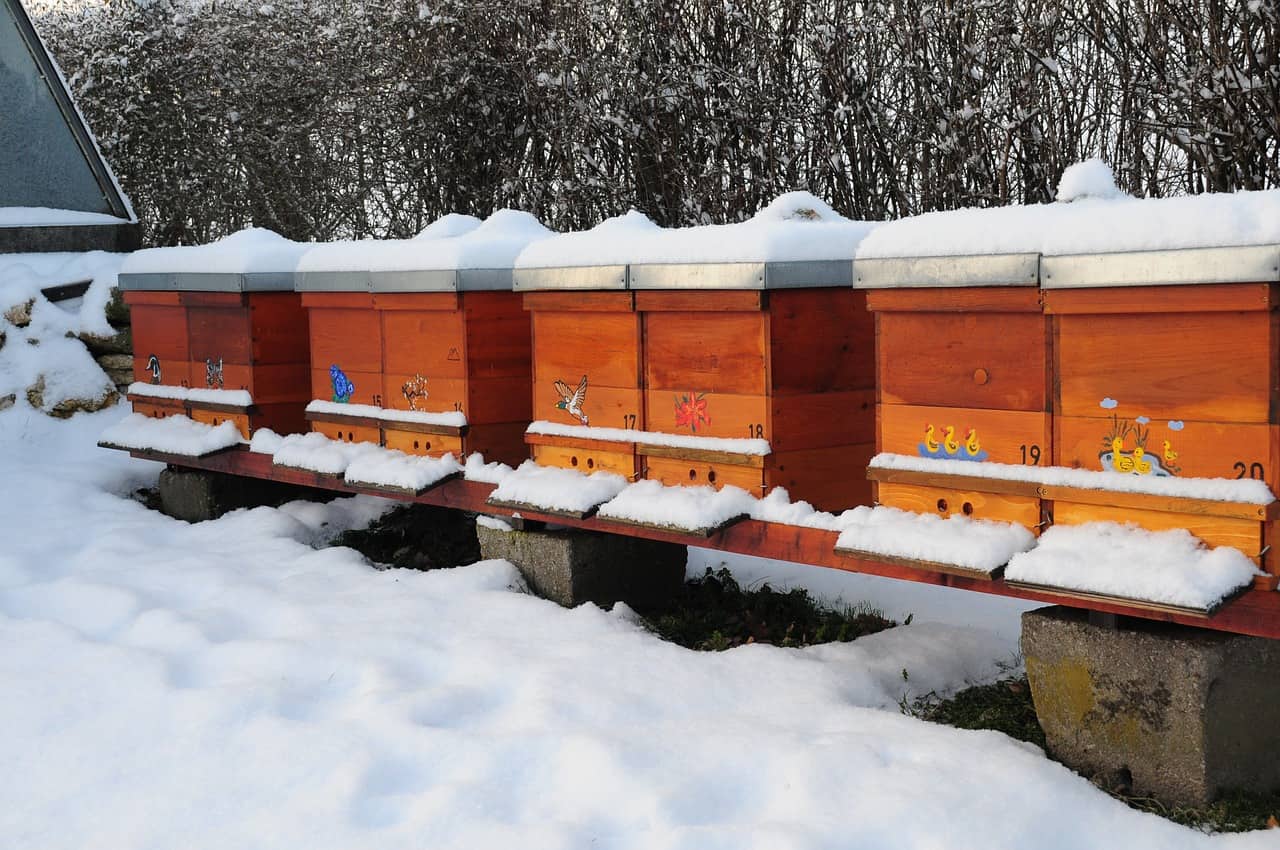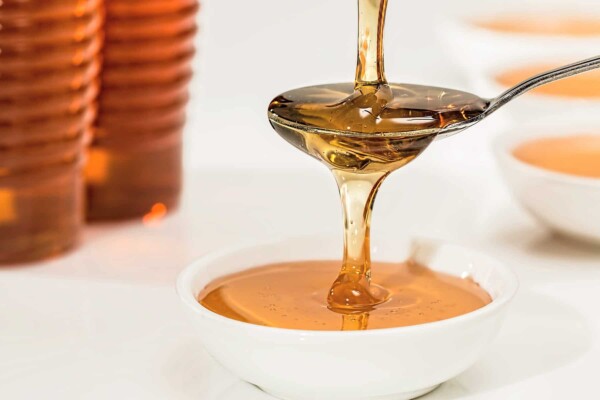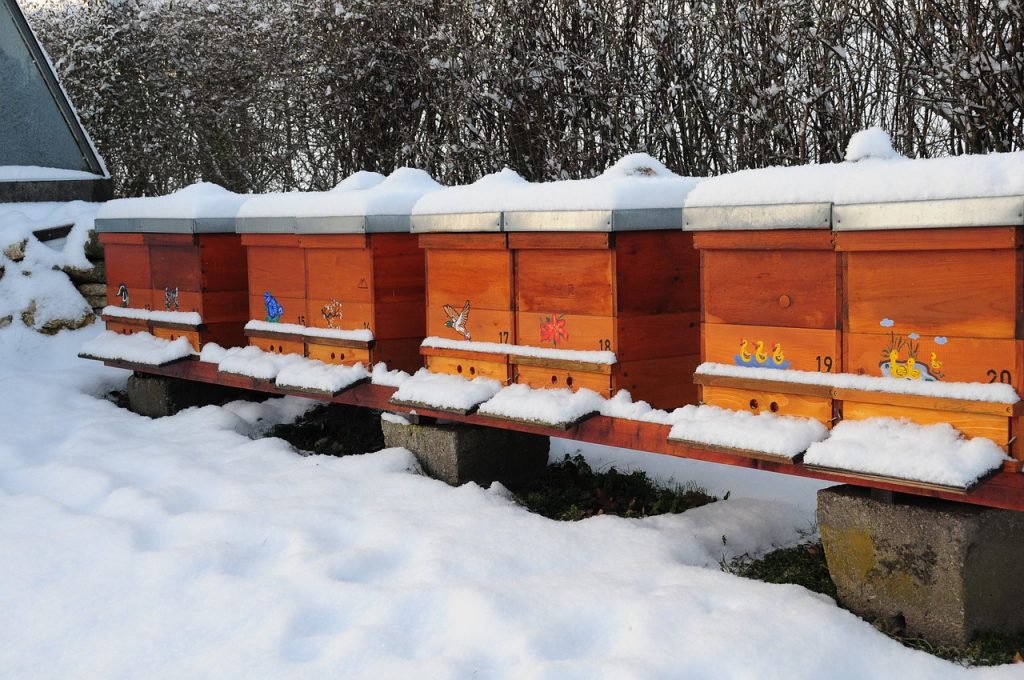
Ever since ancient times, people have consumed bee honey, appreciating it for its rich taste and nourishing properties. The domestication of these insects has taken place since the beginning of civilization, as beekeeping is displayed even in the oldest forms of Egyptian art.
Beekeeping can be practiced by two techniques: stationary or migratory. As the name suggests, stationary beekeeping involves raising bees in one place. Migratory beekeeping, on the other hand, involves moving bees to different places to allow them to pollinate various crops or forests. Thus, you can ensure the production of a significant amount of honey, while helping certain crops to grow.
In general, if you want to make a real profit from beekeeping, the migratory variant is the safest method. Stationary beekeeping can only benefit you if you have the chance to place your hives in a rich honeycomb area. When looking for the right place for your hive, be aware that the flying radius of a bee is 3 km.
Once it multiplies, a bee family will have between 30,000 and 50,000 members, which includes:
- the queen – can be considered queen of the hive, its main role is that of multiplication; it has a life span of up to five years, but in a year it can lay up to 200,000 eggs;
- drones – are male bees who only have the role of mating with the queen;
- worker bees – have a lifespan of about 30 days, during which time they can have three roles: housekeeping bees, nurse bees, and harvester bees.
To communicate with her hive, the queen uses pheromones. If beekeepers do all the necessary maintenance work, but even if the bee family is genetically well developed, they can expect to collect an average of 40-50 kg of honey per year in a hive. Of course, the quantity can increase or decrease depending on the weather conditions.

Winter dead out in the bee colony
One of the most important challenges that beekeepers have to face is the winter dead out. Honey bees reproduce cyclically, so it’s normal to have bigger populations during the spring and summer season and smaller populations during the winter. Sometimes, the smaller bee populations in the hive can cause problems and pose difficulties for the hive to overcome the harsh winter months.
During the winter, bees seek shelter in the hive and survive by consuming stored honey. The hive may look like it no activity at all, but the bee colony is working hard together to survive. Bees don’t hibernate during winter, but they considerably reduce their activities. If the hives are positioned in a region with a warmer climate, where there are a few sunny days during winter, bees will come out of the hive and fly for a little bit.
Many factors can contribute to the death of a bee colony during winter, including the genetic factor, but the most common causes for the winter dead out are extremely low temperatures, condensation that may occur inside the hive and starvation. If this unwanted situation occurs, beekeepers should analyze the bee colony and see which may have caused its death to learn how to prevent something like that in the future.
Extreme cold temperatures cause losses in bee colonies
Bees are cold-blooded creatures so if their body temperature drops too low, they become less active even up to being unable to move. If the bees don’t get warm quickly they will die when it’s really cold outside. To keep themselves warm, bees get close together in the hive into a cluster. The worker bees consume stored honey and use their wing muscles to vibrate and generate heat. However, this ingenious system doesn’t work if the bee population is too low or if they don’t have enough honey stored.
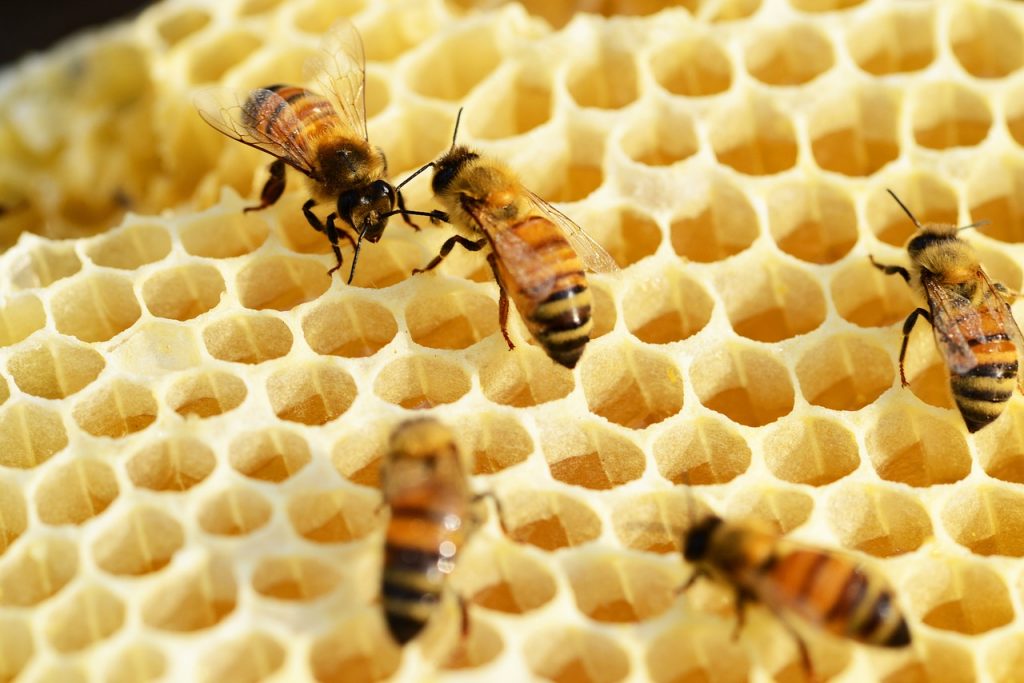
Starvation during winter is a real danger for bees
It may seem that bees starve during winter when there’s not enough honey available, right? But bees can also starve if they can’t reach the honey. Because they tend to cluster together in the hive, they consume the honey they have nearby and don’t move when cold temperatures are lasting for a longer time. Unfortunately, it’s hard for a beekeeper to prevent starvation in the hive.
Condensation has extremely damaging effects on bee colonies
Bees are still busy in the hive even they’re clustered because they eat honey and they generate heat. These activities release moisture and if it’s very cold outside, the moisture that rises at the top of the hive turns into condensation. Bees can cope with cold temperatures, but once they get wet they die. This is why some beekeepers wrap up the hives during winter.
Infestations in the hive
Nosema is a dysentery condition that weakens the bee colony, so if any brown stains all noticeable all over the hive, it’s important to urgently treat the hive for Nosema. Other infestations that can not only weaken but also kill entire bee colonies are varroa and some brood conditions like the American Foulbrood which can occur in certain regions of North America.
Beekeepers check for mite infestations early in the year to take the necessary measures that will help them have a healthy bee colony to survive throughout the winter.
How to prepare the beehives for the winter
Normally, these preparations are made in October, but this can be postponed until the first frost comes. As we know, bees have their defense mechanism against frost and will be organized in a cluster when they feel the cold.
As mentioned above, the organization of the bee colony in the hive is not sufficient to maintain a constant temperature inside it. Therefore, beekeepers must intervene. The most suitable form of wrapping of the hive is the one-sided one, through which all the holes in the hive through which the cold could enter are covered up. Also, the honeycombs will have to be placed on the wall that benefits from the most heat, to be protected from frost.
From the desire to protect bees against the cold as best they can, many inexperienced beekeepers perform too tight insulation of the hives, risking suffocating them. When insulating the hive, it is important to remember to leave two open holes to allow air to circulate inside the hive. Specialists recommend creating holes of about 0.5 centimeters, in the slots located in the warp and the hive floor.
The food needed for winter bees will always be introduced into honeycombs, which will be placed on the hive walls. If the honeycombs are placed at the bottom of the hive, the bees will have trouble forming their cluster and will not be able to feed properly. If there isn’t the possibility to feed the bees with honey, this can be made with the addition of sugar syrup. The mixture will consist of 2 kilograms of sugar and one liter of water, which should be heated and left until the entire composition is homogenized and has a honey-like texture. Placing this syrup in the hive is done just like placing the honey.
With the completion of the preparation of the hives and the arrival of the cold season, the actual works in beekeeping have ended for the year. However, it is important to visit the hives occasionally, to observe any irregularities that have arisen. Depending on the humming of the bees, beekeepers can account for certain events that take place inside the hive.
If the bees make a weak and apathetic hum, they are left without food and beekeepers must urgently intervene to place their food. When a discontinuous and disoriented hum can be heard, it means that the bees in that hive lost their queen. When bee sounds are moderate in intensity and continuous, it means that everything is in order and there is no reason to worry.
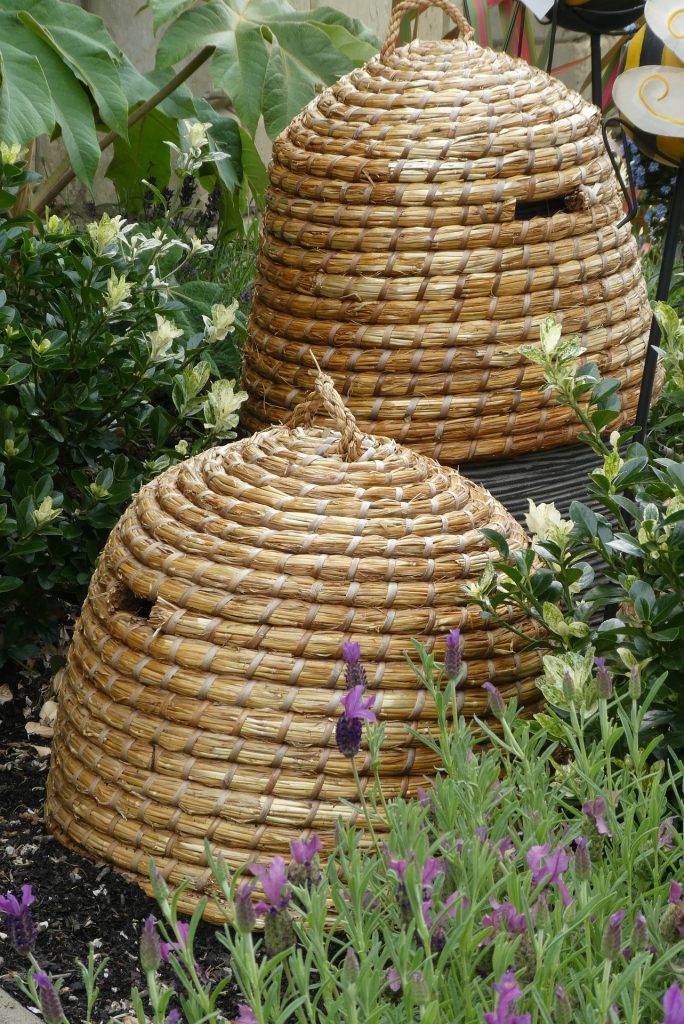
Skep or the primitive hive
In Egypt, bees have been domesticated since ancient times. On the walls of the sun temple of Nyuserre Ini of the fifth dynasty, workers are depicted blowing smoke into beehives to extract honeycombs. Archaeological discoveries related to beekeeping were also found at Rehov, and at the archaeological site of the Iron and Bronze Age in the Jordan Valley, Israel. Thirty intact hives, made of straw and clay, were discovered in the ruins of the city, dating back to 900 BC. The hives were found in orderly rows, three in number and there is evidence that an advanced beekeeping industry existed in ancient Israel 3000 years ago. Beekeeping was also practiced in ancient China. In the book “Golden Rules of Business Success”, written by Fan Li (or Tao Zhu Gong) during the spring and autumn period, there are sections that describe beekeeping, which highlights the importance of the quality of the used wooden box and how it can affect the quality of honey. The first beekeepers used straw baskets (skep) to shelter the bees. This practice is still used in many countries.
The first models were made from wattle then in the Middle Ages straws were used as a raw material straw. Skeps or baskets were used mainly in Northern and Western Europe. In the simplest form, the entrance was at the bottom of the basket. It didn’t have an internal structure. Bees had to build the honeycombs. These had two disadvantages, namely: it wasn’t possible to inspect the bee family if it was sick or there were parasites inside and the second disadvantage was that honey extraction was not easy at all. To extract honey the beekeepers had to shake the basket of bees and then the honeycombs were pressed to extract honey. This hive model was used until the early 20th century after the discoveries made by L. L. Langstroth in beekeeping and the invention of the hive with frames in 1851 tipped the balance in favor of this technology.
In winter, the baskets were laid on mats or wooden platforms, to keep the cold and moisture away. Also, straws were placed on both sides for insulation. The bees insulated the basket with propolis, which has the role of protection against the cold but also against microbes. Wooden or stone shelters were also built, and they had doors for every skep in case of bad weather conditions.
To extract honey beekeepers made a selection of hives at the end of the season. Following this selection, they chose the heaviest hives. The light baskets indicated that the honey bee family does not have much honey and it will not be possible to survive in winter if the honey is taken. Most of the time the bees were drowned in water or smoked with sulfur to extract the honey from the basket. The baskets that were neither too heavy nor too light were kept during the winter until the following year. In this way, beekeeping has been practiced for centuries, and then beekeepers had to look for different methods to avoid losing bee families. For example, shaking the bees from one basket to another or uniting the bee families. If the beekeepers took only part of the honey then the bees were brought back into the basket and thus had a chance to survive in winter. Another method would have been to create a beech tree in May and if the bees filled the basket with honeycombs, an eke (straw ring) was added to give the bees more space to build honeycombs for the brood.
A creative idea to help bee colonies survive the winter season
In the 113 issue from September 13 of The Beekeepers Quarterly, the idea of Ukrainian beekeepers Priyatelenko V. Ya, Ilienko E.I. and Fursov V.N. was featured. Their idea was to design a type of hive that can replicate a tree trunk to help bees build a nest, as they would do in natural conditions.
The basic idea of this type of hive is to place the frames of the boxes crisscrossed on top of each other, to create a two or three-story colony. This is an improved design of the hive used by I. I. Korablev in 1929. When the new design was tested, beekeepers have found that the maintenance is much easier and it takes less time to manipulate the colonies. It was beneficial not only for beekeepers but also for the bees, because they showed signs of health improvement, particularly because the water was condensed on the layers of propolis that can be found within the nest.
Main features of a three-story hive:
- Improved ventilation by designing a special place at the bottom of the hive;
- All the hive frames have a modified design that includes an “n”-shaped upper metal bar used to secure the honeycomb;
- The different boxes have different orientations which can be used for warm days (upper and lower boxes) and for cold days (the middlebox);
- The frames can easily be separated and removed in the hive because the wax is the only connection sued for the intersections.
Main advantages of the three-story hive:
- Improved ventilation in the hive;
- Easy removal of drone brood combs;
- The bees can use the condensed moisture from the surface of the propolis layer while the hive is naturally disinfected and free from microorganisms;
- By using just one box of stores during winter, or two in the case of stronger colonies, bees rationally use the stored honey during winter (the studies have shown an improvement of 100% survival during 7 years);
- Few manipulations of the hive are required throughout the year;
- Improved honey production;
- Healthier conditions for the bee colony;
- Simplified management of the bee colony.

Other ways to prevent bee losses during winter
Prevent Varroa attacks
When the treatment against this pest was not done, or it was not properly administered many times, beekeepers may find dead bees on the bottom of the hive, with the wings spread, having behind the head or somewhere under the wing a reddish-brown louse. Many bees may not have mites anymore, but they may be present at the bottom of the hive. Varroa destructor is perhaps one of the main causes of mortality in many hives. This pest, especially if the beekeeper is not careful, can destroy a family of bees. During the winter it is very difficult to intervene, given that the bees are in the form of a cluster, and the treatment has no physical capacity to neutralize the pest.
Diarrhea and Nosema
These two causes are identical in the way they manifest themselves in winter and also because only an examination in a specialized laboratory can tell if the diarrhea in a bee family is caused by Nosema or is just a digestive disorder caused by poor nutrition or uncleanliness. Indications that the bee family has serious problems appear even before opening the hive lid. For example, from a hive with a family of diarrhea bees, the beekeeper can observe how from time to time bees begin to emerge, even if the weather conditions are unfavorable. Also, if there is snow near the hive, then chances are that the white snow layer will show some brown spots of excrement from place to place. When undoing the cover and the lining to open the boxes, beekeepers have to face a strong, unpleasant smell.
The causes of diarrhea can be multiple. One of them would be Nosema or “the misery disease”, caused by a naturally occurring parasite in most hives, but which produces negative effects when other negative factors weaken the immune system of bees. Diarrhea independent of nosema can be caused by the reserve of altered honey, winter feeding of bees sunflower honey, lack of queen, a cold draft in the hive and generally any kind of stress because in negative conditions bees consume much more honey, therefore their intestines will have to retain much more residue. The effect will be all the more pronounced as the period when the bees can exit for the clean-up flight is late.
Watch out for birds and rats
First of all, a rat attack can destroy a bee colony. They cannot be defended, because they are gathered in the cluster, and once released at very low temperatures in winter, the bees are numb and therefore easy prey for rats or birds. Usually, the rats consume the bees’ head first, because they fear the needle from their dorsal side. For this reason, in bee-related works, it is said that the presence of headless bees on the bottom of the hive indicates the presence of mice or rats in the hive.
Some birds attack beehives but the losses are usually bigger not because they eat the bees but because they try to break the wooden hives with their beaks and stress out the bees inside.
Don’t shake or handle hives roughly
It must be known that the survival of the bee colony during the winter is because they gather in the hive where through rhythmic beatings of the wings they warm the hive center at temperatures higher than 30 Celsius degrees. The temperature gradually drops from the middle to the outside of the cluster. If the hive is shaken, the cluster may break, and the bees then gather in smaller clusters where they cannot cope with the cold and die.
Taking care of bee colonies during winter is not an easy task, but it is not something that can’t be managed if beekeepers pay attention to any signs that can show something is not right and make the necessary preparations for the hives to offer good shelter for bees at low temperatures.
Contents
- Winter dead out in the bee colony
- Extreme cold temperatures cause losses in bee colonies
- Starvation during winter is a real danger for bees
- Condensation has extremely damaging effects on bee colonies
- Infestations in the hive
- How to prepare the beehives for the winter
- Skep or the primitive hive
- A creative idea to help bee colonies survive the winter season
- Other ways to prevent bee losses during winter

